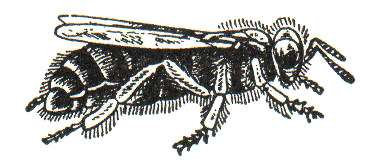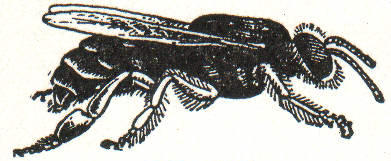Reading Passage 3
The honey bee, or apis mellifera, is a fascinating insect. They live in big families or swarms. These swarms have historically been appeared in varying climatic and geographical zones, as long as flowering plants were present there. Natural selection and evolution ensured gradual improvement of the species. Eventually, biological differences shaped the honey bee that inhabits our planet today. Nowadays there exist three distinct types of honey bees, each with defined duties and responsibilities.
The Worker Bee
The predominant type of bee in the hive, they are exclusively female. However, over the course of evolution, they have been deprived of the ability to mate with male bees and, therefore, have offspring. Neither their deteriorated reproductive organs nor the size of their bodies allow that. However, female bees retained their maternal instincts, which makes the young of the hive their prime concern. They have gained and, in the evolutionary course, greatly developed other qualities important for a family member: they feel the urge to build shelter and gather food for future use; they ensure that the larvae are satiated; and their hive is warm and well-protected from intruders. The working bee does everything to make the hive function properly.
The Queen

The queen does not normally leave the hive. There are several occasions when she does so—one of them is the period of chastity to search for mating partners. It makes its first venture out of the hive to scout the surroundings, usually during the warm and quiet morning hours while drone bees are still inside the nest. The only other time the queen leaves her nest is for mating rituals. This usually coincides with the period when young bees go out to learn the vicinity of their hive for their future pollination duties. The queen can go as far as 7 kilometres away from the apiary (or hive, for wild bees). At such a great distance from her home, she is likely to encounter drones from other families, reducing the chances of inbreeding.
A newly-born queen is yet to be considered the supreme mother of the bee family, as she isn’t fertile at this point. It is only after several days that she reaches puberty and, with it, the ability to lay eggs after mating with drones. After her first mating eggs start growing inside her bosom, her belly grows larger, and she turns bulky and cumbersome. The queen becomes slow; her movement—paced and gracious. The queen resides in empty honeycombs that she uses to lay eggs. Those eggs are of two types: fertilised and unfertilized. The former give life to female specimens—working bees and other queens—while the latter bring males, or drones. The queen is the cornerstone insect of the swarm, regulating the pace at which it functions, its population, and its prosperity. The queen is the sole ruler of the bee society.
However, the queen bee is nothing without her humble servants. She won’t be able to lay an egg unless the worker bees prepare a honeycomb for it. She is totally reliant on worker bees for food and protection because her size doesn’t allow her to either provide for or defend herself. It is the ultimate goal for any bee to ensure that the queen is safe, happy, and has everything in abundance. And that isn’t surprising—if the queen dies, the whole societal structure of the hive collapses. That is why whenever a queen falls ill, the bees grow agitated and promptly hatch another queen by feeding a larva with royal jelly exclusively.
The Drone

Drones are hatched at the end of spring, when the hive has enough strength to start swarming. Drones are male bees whose primary and only goal is to fertilise the queen. Without them, bees would not be able to procreate, so technically, they are as important as the queen. Bees try to hatch as many drones as they can sustain to ensure female impregnation. They spare no expense in bringing drones up—a growing drone eats up to six times more than a worker bee. Among other foods, an adult drone consumes bee bread, a staple consisting of honey and pollen.
Drones usually mate in the air at an altitude of up to 30 meters. They might choose to travel far away from their hive to find a mating partner, so they require an acute sense of smell to track a bee queen down as well as sharp eyesight and strength to see and catch her. A drone’s eye has up to eight thousand facets, compared to only four or five thousand for a worker bee. This grants drones extreme spatial awareness and a quick reaction capacity to any changes around them. They are also blessed with longer antennae—the bee’s organ of smell. They can sense the presence of a bee queen from 50 metres away.
Drones are exempt from any work in the hive. They do not take part in defending it; they can’t even get food to feed themselves and would starve if it weren’t for worker bees. Their only raison d’etre is to impregnate bee queens. Nature has liberated drones from any duties other than the procreative one. This all comes at a great cost, though. After the mating with the queen is over, the drone dies. Drones are part of the bee family for only as long as the swarming period lasts. After that, drones are exiled, their purpose fulfilled, and no longer needed.
Questions 27-35
Complete the table below.
Choose NO MORE THAN ONE WORD from Reading Passage 3 for each answer.
Questions 36-40
Do the following statements agree with the information in Reading Passage 2?
Write …
TRUE if the statement agrees with the information
FALSE if the statement contradicts the information
NOT GIVEN if there is no information on this
36. Worker bees constitute the majority of the hive population
37. There can only be one queen in the hive at a time
38. The gender of a newborn bee is decided by chance
39. Drones are larger than worker bees in size
40. Drone’s perception is better than that of a worker bee.
For this task: Answer keys :: Vocabulary

